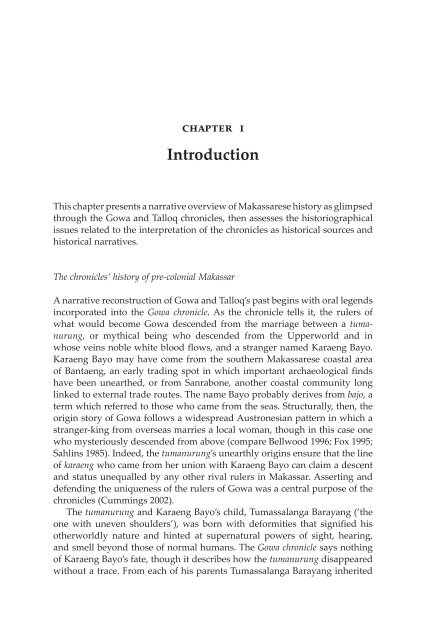A CHAIN OF KINGS - Books and Journals
A CHAIN OF KINGS - Books and Journals
A CHAIN OF KINGS - Books and Journals
Create successful ePaper yourself
Turn your PDF publications into a flip-book with our unique Google optimized e-Paper software.
chapter i<br />
Introduction<br />
This chapter presents a narrative overview of Makassarese history as glimpsed<br />
through the Gowa <strong>and</strong> Talloq chronicles, then assesses the historiographical<br />
issues related to the interpretation of the chronicles as historical sources <strong>and</strong><br />
historical narratives.<br />
The chronicles’ history of pre-colonial Makassar<br />
A narrative reconstruction of Gowa <strong>and</strong> Talloq’s past begins with oral legends<br />
incorporated into the Gowa chronicle. As the chronicle tells it, the rulers of<br />
what would become Gowa descended from the marriage between a tumanurung,<br />
or mythical being who descended from the Upperworld <strong>and</strong> in<br />
whose veins noble white blood flows, <strong>and</strong> a stranger named Karaeng Bayo.<br />
Karaeng Bayo may have come from the southern Makassarese coastal area<br />
of Bantaeng, an early trading spot in which important archaeological finds<br />
have been unearthed, or from Sanrabone, another coastal community long<br />
linked to external trade routes. The name Bayo probably derives from bajo, a<br />
term which referred to those who came from the seas. Structurally, then, the<br />
origin story of Gowa follows a widespread Austronesian pattern in which a<br />
stranger-king from overseas marries a local woman, though in this case one<br />
who mysteriously descended from above (compare Bellwood 1996; Fox 1995;<br />
Sahlins 1985). Indeed, the tumanurung’s unearthly origins ensure that the line<br />
of karaeng who came from her union with Karaeng Bayo can claim a descent<br />
<strong>and</strong> status unequalled by any other rival rulers in Makassar. Asserting <strong>and</strong><br />
defending the uniqueness of the rulers of Gowa was a central purpose of the<br />
chronicles (Cummings 2002).<br />
The tumanurung <strong>and</strong> Karaeng Bayo’s child, Tumassalanga Barayang (‘the<br />
one with uneven shoulders’), was born with deformities that signified his<br />
otherworldly nature <strong>and</strong> hinted at supernatural powers of sight, hearing,<br />
<strong>and</strong> smell beyond those of normal humans. The Gowa chronicle says nothing<br />
of Karaeng Bayo’s fate, though it describes how the tumanurung disappeared<br />
without a trace. From each of his parents Tumassalanga Barayang inherited









![Am HaSefer [Volk des Buches] - Books and Journals](https://img.yumpu.com/20648352/1/174x260/am-hasefer-volk-des-buches-books-and-journals.jpg?quality=85)







